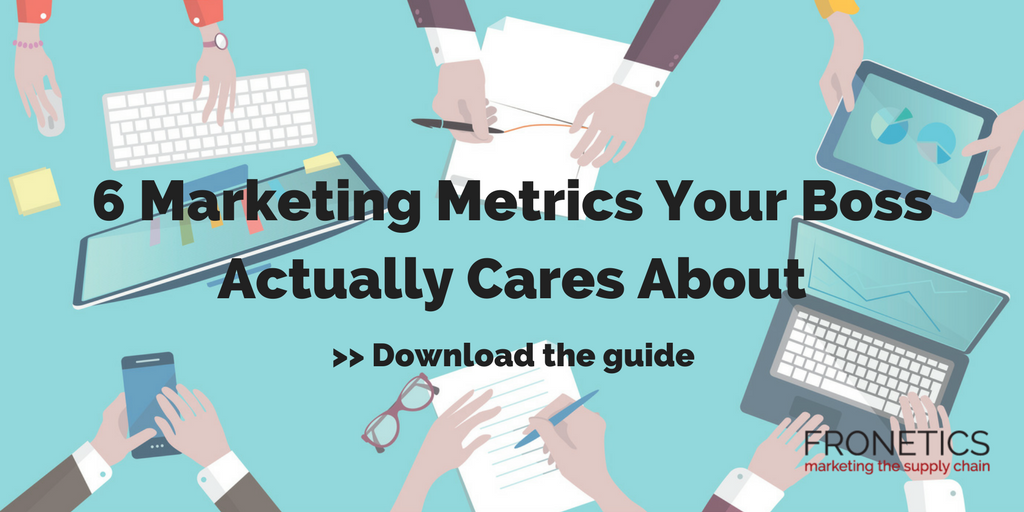
by Fronetics | Jul 11, 2017 | Blog, Content Marketing, Marketing, Social Media, Strategy
Take an honest assessment of these 6 areas to see if outsourcing your marketing might be a smart move.
Supply chain companies are increasingly open to outsourcing their logistics because it allows them to focus on their core competencies while improving productivity. So why not apply the same rationale to bolster your marketing efforts? Don’t be afraid to look outside the box for the marketing tools you need to succeed.
As your competitors’ marketing budgets continue to climb, your company needs expertise on your side to get the most out of your marketing dollars — and that’s especially true in the digital space. Content marketing can be very challenging for novices and seasoned marketers alike. Blogging, paid search and social advertising, email marketing, social media management: there’s a lot to juggle. That’s why many companies are outsourcing some — or all — of their marketing programs.
Have you considered outsourcing as an option? Maybe it’s time you did. Parsing out certain projects on an as-needed basis to an outside firm can help you comfortably navigate and succeed in the marketing world.
6 signs you should outsource your marketing
Assess your staff in these six areas to determine if it’s time to explore outsourcing your marketing efforts.
1) “Wait, what’s going on with social media now?”
Do you feel like your company is always reacting to marketing trends instead of planning for them? You need to be one step ahead of what’s coming, especially in fast-changing spaces like social media, in order to meet your customers where they are.
Learning best practices and new tools can be challenging, especially if you’re time strapped. Using an outside firm with expertise across the spectrum — and whose job depends on knowing the newest platforms and media — will give you an edge over competitors.
2) Everyone is at capacity.
Is your current marketing team able to take on new projects easily, without compromising existing responsibilities? If your staff has great ideas but not the resources to initiate them or follow through, you need to find a way to fix that.
Consider breaking off projects to an outside firm, even on a trial basis to test the waters. Plus if you outsource to experts, you won’t have to reinvent the wheel in-house or risk being off trend.
3) You lack time for proper strategizing and assessment.
Do you have a unified marketing strategy in place with a way to measure objectives and results? If you’re too busy keeping up with day-to-day work to step back and plan, then regularly assess how things are going, consider outsourcing.
Creating a strategy with short- and long-term goals is essential to marketing success. Using an agency to create a roadmap for you — and then to track progress — will free you up to focus on running your business. Also, an objective audit of your practices can be truly beneficial and will only improve your strategies.
3) You only have time to focus on one or two platforms/areas/ideas.
Are your marketing channels diversified? Your marketing reach needs to extend to all avenues, particularly in the digital world. Outsourcing SEO, paid search and social advertising, blogging and social media projects is a relatively easy task to manage and is absolutely essential for success in the current world.
4) You can’t afford another hire.
Are you on a tight budget? If your budget doesn’t allow for hiring and training key staff, outsourcing your marketing needs is a way to grow your reach and accomplish your goals without generating overhead such as training costs, benefits or payroll expenses. It’s also a way to try out new projects and programs to see if they stick.
5) You don’t have time for professional development.
Is there a skillset you and your employees want to advance? Gauge the temperature of your existing staff to ensure everyone’s needs are being met. Retaining top talent isn’t easy, so keep in mind that you don’t want existing employees to be concerned about their job security.
Identity each in-house staff member’s strengths and interests, and cultivate them. For example, encourage a designer to add a new skill to his or her portfolio, or an analyst to take a webinar or class to become even savvier. Strength what you have but look to complete your marketing toolkit with the available expertise.
Related posts:

by Fronetics | Jul 6, 2017 | Blog, Content Marketing, Data/Analytics, Marketing
Businesses report these 3 content marketing challenges are the largest they face. Here’s how to track your progress in overcoming them.
Is content marketing working well for your business? If not, you are not alone. Though it is one of the most effective ways to grow your business, content marketing has been challenging B2B and B2C organizations since its inception.
You may think it should be simple: Write, post, get more customers. But content marketing is much more complex, demanding more time, thought, and careful strategy than churning out a few blog posts.
First and foremost, what you produce must engage readers. This is, however, one of the biggest content marketing challenges facing both B2B and B2C marketers.
In fact, the 2017 State of Inbound Report found that content creation is just the tip of the iceberg in terms of content marketing challenges that businesses face. Here are 3 marketing challenges and ways to track your progress in overcoming them.
3 content marketing challenges
1. Generating traffic and leads
Echoing their priorities, marketers today find generating traffic and leads to be their biggest challenge. In fact, 61% of those surveyed listed it as their number one challenge. ‘Content is king’ has become a marketing mantra, but how can you turn your content into actual leads that turn into sales?
Tying revenue directly to publishing and distributing content can be difficult. Thinking about social media content within the context of your entire sales funnel can make it easier to determine effectiveness. Content is typically used to attract leads, to encourage readers to subscribe to your blog, or to have prospects submit contact info to get higher-value content. Continued engagement nurtures leads and moves them further down the sales funnel.
Track this: The cost to get a lead. You can then determine the percentage of leads that move on to become qualified leads, the percentage of qualified leads that then become opportunities, and the percentage of opportunities that are ultimately won. At the end of the day, you’ll be able to calculate the revenue generated from leads that entered the funnel from your content marketing efforts.
2. Proving the ROI of marketing activities
Coming in at a close second, 43% of marketers felt that proving their ROI from content marketing activities was their biggest challenge.
Whether launching a product or a new social media campaign, we look for instantaneous numbers that will affirm we made the right choices. But here’s the problem: Not all metrics are created equal. Content marketing ROI is harder to confirm than checking a few quick numbers.
Lean-startup pioneer Eric Reis said, “The only metrics that entrepreneurs should invest energy in collecting are those that help them make decisions.” In other words, measuring your ROI will tell you if an effort was profitable so you know where to put your time and money.
ROI can help you determine whether it was worth spending your resources in a particular way. This is extremely useful on platforms like blogs and social media, where things are constantly changing. Using ROI as a litmus test, you can keep experimenting and making sure you’re using these tools effectively.
Track this: Use tools like HubSpot, Hootsuite, and built-in analytics platforms like Twitter Analytics, Facebook Insight, and YouTube Analytics to track detailed information about engagement with your content.
3. Budget
Organizations that have a documented content marketing strategy are more likely to be successful than those that don’t. But setting aside the funds to develop and implement these strategies can be tricky.
The State of Inbound Report found that 30% of marketers struggle to secure a budget for their marketing efforts. Content marketing competes with other marketing campaigns (outbound, native, etc.) for funding. The Content Marketing Institute’s latest trends report states that, on average, 29% of B2B brands’ total marketing budget is spent on content marketing, leaving a majority of funding going toward other efforts.
Content marketing is here to stay. In fact, it’s at its best when it’s integrated with your other marketing efforts, becoming a part of your entire marketing strategy.
Track this: Content marketing serves every marketing channel. Experiment with overlapping marketing budgets to increase your efforts for whitepapers, sales collateral, social media posts, and to make sure your advertisements and visual messaging are in sync. Content serves every marketing channel, so you’re wasting time claiming you don’t have the budget.
Related posts:


by Fronetics | Jul 5, 2017 | Blog, Talent
Thinking of making a professional change? Here are some questions to consider before taking the plunge and overcommitting.
We’ve all been asked to take on new projects at work when we’re already completely swamped. In the moment, it can be very hard to say no. And we’ve all jumped on LinkedIn to see what other opportunities are out there. More money, less headaches. The grass is always greener.
I recently read an article in the Harvard Business Review about asking some tough questions of yourself before making a professional change. It got me thinking about our tendency (my tendency) to overcommit.
Executive and life coach Regan Walsh’s article, Before You Agree to Take on New Work, Ask 3 Questions, offers three key questions to ask before making any major professional decisions. Walsh believes that you need to move past the “should” in order to find fulfillment in your work.
Shoulds and wants
“Shoulds are the things we do out of obligation because we have not thoughtfully considered our true objectives, even out of fear,” she writes. “What if we never get another opportunity? What will others think of us if we say no? What will we think of ourselves if we say no? Sometimes, shoulds even seem like things we want to do.”
But honestly, shoulds are often things that are in direct opposition of our wants. Instead of focusing on professional goals and aspirations, we become burnt out by the “must dos.”
We must keep moving up the corporate ladder. We must take that promotion that means double the workload. We must say yes to new projects that could lead to new opportunities.
It’s worth taking a pause to consider why you’re making a professional change and if it will, in fact, be for the better.
3 questions to ask yourself
Here are three simple questions to ask yourself before making any major professional decisions.
1. What is my motivation?
Ideally your motivation for any professional change will come from within. Oftentimes this is easier said than done. External factors can play a large role in motivating our decisions. Money, professional growth, a new title — these are hard incentives to ignore.
But if you’re seeking more than just employment, real fulfillment from your job, you should start with your passions. If you’re making decisions based on your interests, your job will become more than a paycheck.
More and more employees are seeking a sense of community, educational opportunities, and a sense of purpose from their career paths. Aligning these opportunities with your personal interests will help make your job more than just a way to pay your mortgage.
2. Does it align with my values?
To answer this question, you need to identify what your core values are. What matters to you? What principles do you live by?
For most of us, these core values can include honesty and integrity. You can find these words in endless corporate value statements, but saying it and living are very different. If you can find an organization that stands by its value statements and works to embody these values, you will find that a sense of pride in your professional setting.
In a world based on data and analytics, finding an organization that can move past the numbers to create opportunities for its employees that will make them better members of their community will increase employees’ commitment to their company.
“Ideally, an organization’s core values explicitly define how people will behave with each other and with customers. When values succeed, the daily behaviors of your people will embody the core values you set forth,” Chris Cancialosi says in 2 Ways to Ensure Your Corporate Culture and Values Align.
3. Do I have a choice?
Your supervisor walks into your office and announces a new project she’d like you to spearhead. Your first reaction might be flattery and pride. Taking a step back, you might ask yourself, “Did I have a choice?” Were you forced into taking on more work? Are you even interested in the project?
Self-determination theory suggests that in order to act, or to feel motivated to act, we need to feel that we’re in control. We’ll enjoy something more if we recognize that it’s a choice.
Just as in our personal lives, when we feel like we have a choice in the matter, we’re more likely to give it our best effort.
Companies are expecting more and more of employees, and often in less time. It’s easy to get overwhelmed. Taking a step back to realize you have a choice in the matter — or, at the very least, the ability to communicate these feelings with your employer — will help you keep a balance at work.
Before taking on new projects or additional workloads, consider how much time it will take to complete the assignments and how much impact it will have on your existing workload.
We are all influenced by obligations. It’s easy to say yes to things, professionally and personally, because we feel like we have to. In order to feel real satisfaction from our professional choices, we need to look internally. Saying yes to things that align with your core values and being motivated by your passions takes time and practice, but the end results will far outweigh the shoulds.
Related posts:

by Fronetics | Jul 3, 2017 | Blog, Content Marketing, Current Events, Marketing, Supply Chain
Blog aggregation site Feedspot included Fronetics’ blog on its list of the best content for the supply chain.
Fronetics is honored to learn that our blog has been included on Feedspot’s list of the top 75 supply chain blogs and websites for supply chain professionals. The blog aggregation website has indexed thousands of supply chain blogs and pulled out the most popular using search and social metrics.
Feedspot explains its methodology. “These blogs are ranked based on following criteria:
- “Google reputation and Google search ranking
- “Influence and popularity on Facebook, Twitter and other social media sites
- “Quality and consistency of posts.
- “Feedspot’s editorial team and expert review.”
We are in excellent company on this list. And we love seeing friends and frequent content collaborators like Argentus and SCM Talent Group among the best of the best as well. These are the places where we turn for supply chain thought leadership, and are humbled to be included.
Fronetics strives to be a leading industry resource for information about digital and content marketing, so it is very exciting to be recognized in this way. Thank you to Feedspot, our contributors, and all of our readers who turn to Fronetics for the latest information about content marketing, social media, and more news and happenings in the supply chain industry.
Related posts:


by Fronetics | Jun 28, 2017 | Blog, Current Events, Marketing, Social Media
In June’s social media news, more social media platforms are making changes to benefit businesses who advertise.
June has seen a lot of recent changes in big-name platforms, like Facebook, Instagram and Twitter, that will directly impact the engagement between businesses and potential customers. The trend is to create apps that work harder for paid advertisers, increasing brand awareness for businesses and proving their worth through built-in tracking.
Apple has also been working overtime to keep their products competing with the big players in the social media game. New analytics and introduction of Business Chat are keeping the fruit relevant.
Facebook Rolls Out Two New Ad Campaign Tools for Marketers
Facebook delivered two new options for helping businesses grow: Valued Optimization and Lookalike Audiences. The first, Valued Optimization, “works by using the purchase values sent from the Facebook pixel to estimate how much a person may spend with your business over a seven-day period. The ad’s bid is then automatically adjusted based on this estimation, allowing campaigns to deliver ads to people likely to spend more with your business at a low cost.” The second, Lookalike Audiences, helps marketers reach people likely to be interested in a business based on people who have visited their site. Read more
Facebook Expands Click to Messenger Ads to Instagram
Facebook continues to expand ways for users to connect directly with businesses. The Click to Messenger ads have been available through Facebook for a while, and now they’re expanding to Instagram. “Instagram Click to Messenger ads let you reach the people you care about on Instagram and engage with them on Messenger.” Read more
Instagram Makes Sponsored Content More Transparent
Last week Instagram introduced a new “paid partnership tag” that will clearly identify sponsored posts on its app. “Partnerships between community creators and businesses are an important part of the Instagram experience, and a healthy community should be open and consistent about paid partnerships.” This new tag will help users determine when posts are influenced by commercial relationships with businesses. Read more
Apple Rolls Out Analytics to Podcast App
During a podcast session at WWDC, the Apple developer conference, Apple announced that its podcast app will now have the ability to give publishers data that tells them just how much of their episodes are actually being listening to. Apple Podcasts app will allow creators to track aggregated data about when users start, stop, and skip within an episode. This data will give podcasts tangible results that were once estimated from the number of downloads a podcast received. Read more
Apple Debuts Business Chat
Business Chat allows real customer service representatives to communicate directly with users through iMessage. According to the Apple Developer site, customers can use this new feature to “find your business and start conversations from Safari, Maps, Spotlight, and Siri.” The Verge reports that “there will be built-in features like Apple Pay and calendar integration, which will allow Business Chat to facilitate purchases without requiring the user to exit the chat.” Read more
Twitter Experiments with New Promotional Features for Sponsored Live Video
After entering into an exclusive partnership with Live Nation, Twitter is experimenting with new features to help promote events featured on LN. New features like an alert that users can set to remind them of the live event or a branded timeline that will put all tweets about the event on one landing page will help strengthen the relationship between Twitter and Live Nation, paving the way for more partnerships with big brands. Read more
Related posts:







